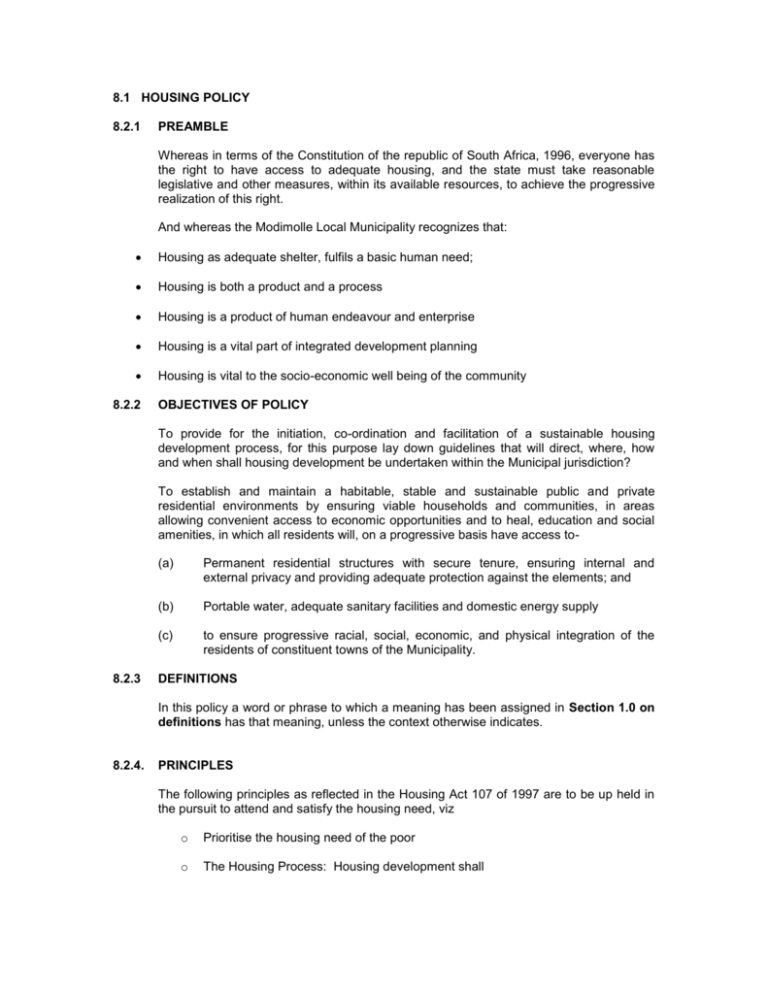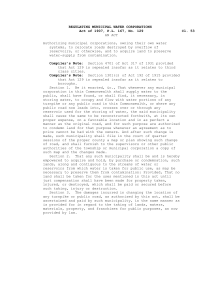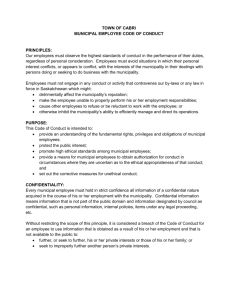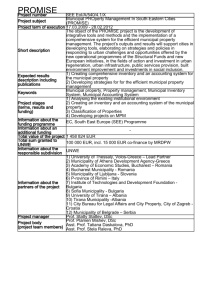HOUSING POLICY - Modimolle Local Municipality
advertisement

8.1 HOUSING POLICY 8.2.1 PREAMBLE Whereas in terms of the Constitution of the republic of South Africa, 1996, everyone has the right to have access to adequate housing, and the state must take reasonable legislative and other measures, within its available resources, to achieve the progressive realization of this right. And whereas the Modimolle Local Municipality recognizes that: Housing as adequate shelter, fulfils a basic human need; Housing is both a product and a process Housing is a product of human endeavour and enterprise Housing is a vital part of integrated development planning Housing is vital to the socio-economic well being of the community 8.2.2 OBJECTIVES OF POLICY To provide for the initiation, co-ordination and facilitation of a sustainable housing development process, for this purpose lay down guidelines that will direct, where, how and when shall housing development be undertaken within the Municipal jurisdiction? To establish and maintain a habitable, stable and sustainable public and private residential environments by ensuring viable households and communities, in areas allowing convenient access to economic opportunities and to heal, education and social amenities, in which all residents will, on a progressive basis have access to- 8.2.3 (a) Permanent residential structures with secure tenure, ensuring internal and external privacy and providing adequate protection against the elements; and (b) Portable water, adequate sanitary facilities and domestic energy supply (c) to ensure progressive racial, social, economic, and physical integration of the residents of constituent towns of the Municipality. DEFINITIONS In this policy a word or phrase to which a meaning has been assigned in Section 1.0 on definitions has that meaning, unless the context otherwise indicates. 8.2.4. PRINCIPLES The following principles as reflected in the Housing Act 107 of 1997 are to be up held in the pursuit to attend and satisfy the housing need, viz o Prioritise the housing need of the poor o The Housing Process: Housing development shall 8.2.5 o Provide as wide a choice of housing and tenure options as a reasonable possible o Be economically, fiscally, socially and financially affordable and sustainable. o Be based on integrated development planning o Consider and address the impact of the environment o Be administered in a transparent, accountable and equitable manner, based on the principles of good governance Empowerment Through Capacitating: the Municipality shall encourage and support individuals and communities, including cooperatives, association(s), and other community based bodies, in fulfilling their own housing needs in a way that ensures skills transfer and community empowerment. STRATEGIC OBJECTIVES Urban Land fills This is an initiative to make full use of the available land (that is, serviced and unserviced) earmarked for housing development. The objective being to prioritize the development of these portions of land as opposed to initiatives to look for large and open lands, which require huge investment on infrastructure and other social amenities. These areas are given priority because they are mostly located nearer to already established social amenities, businesses or industrial regions which may offer employment opportunities, transport routes, etc. The basic philosophy of this initiative is the belief in a compact and functional town/city, efficient in its use of resources, space and opportunities. This philosophy is not necessarily contradictory to other initiatives at establishing breathing and environmentally sustainable town/city. The identification and prioritization of such portions of land is necessary and important so as to begin the process of assessing and evaluating development proposals and setting time frames. Eradication of Informal settlements The development of informal settlements in urban areas does generally indicate either a lack of urban planning or the inability of the town to cope with rapid urbanization/influx of people into the town/city. They can either be a product of an organized campaign or movement to invade open portions of lands located at the periphery of the town, or it may be as the act of desperation by traumatized people in need of housing. What ever the reason for the emergence of such areas, they are by their own characteristics a threat of human life and dignity. Informal settlements are generally inaccessible, filthy, and dark and serve as safe havens for criminals. Their existence is therefore undesirable as they are a threat social stability and thus they must be eradicated. The process and interventions to do away with informal settlements must be informed by the desires and needs of their inhabitants, in so far as they can be met within the available resources of the Municipality and are not in conflict with any National or Provincial legislations and regulations, and Municipal strategic development policies. The prevention of further expansion of existing informal settlements and development of new ones is of critical importance to any successful systematic development of urban areas. This means that a proactive strategy, to manage rapid urbanization without infringing upon peoples right to freedom of movement and right to housing, is necessary. This strategy must be linked to the Municipality’s housing development objectives/goals. The strategy could include the up grading of such area into formal townships in as far as geographic location allows. Such an initiative must be underpinned by secure tenure and provision of basic or adequate municipal services. Where such an initiative is not feasible an alternative land for resettlement will be logical step and shall thus involve relocation. Such an alternative land, however must not perpetuate dislocation and displacement. Urban Reception South African is a developing country, which likes any other similar country in the world, is experiencing a rapid movement of households from rural areas and surrounding commercial farms into urban areas. There do not exist legal remedies, which are in line with the Constitution of the republic, to prevent such a movement. So it is left to each Municipality to find a way to manage this phenomenon. One such an attempt will be establish reception area, where all new comers will be settled until an appropriate and permanent housing opportunity is allocated to those households. Such an area could also accommodate current back yard lodgers in existing township. Such areas could be established in the three Municipal regions to address local needs. A reception area shall be an organized settlement area with most of the municipal services and be under the management of the Municipality. Social, Economic and Physical Integration The apartheid’s objective as a social policy had been to enforce segregation along racial lines through a spatial policy that prescribe separate development of the physical environment for each racial and tribal group. It also separated peoples along economic lines, drawing distinction lines between the poor, middle income and the rich through the location of their habitat. These features are apparent to see in the Modimolle Local Municipality areas. Thus a spatial development plan must given direction to endeavours to alter this physically disintegrated environment. This requirement is based on the understanding that the priorities of urban residents are not necessarily limited to adequate housing; they also include employment, proximity of shopping and work places, educational facilities, good social cohesion and safe neighbourhood. It is submitted that not only South African citizens that are in need of housing or proper accommodation when they come into urban areas, but also foreigners from neighbouring countries. Though foreigners do not qualify for state subsidized housing, they however are protected by the Constitution of the Republic as human beings. Their need for housing or accommodation must be met in some way to preserve human dignity. Therefore, housing development in Modimolle Local Municipality must take into account the need to ensure a socially, economically and physically integrated society over a period of time. New housing development projects must be located in close proximity to existing main infrastructure networks. In order to ensure prompt realization of these ideals of integration it must be a priority to acquire land, which is closer to the existing urban economic nodes for housing development. 8.2.6 HOUSING DELIVERY Housing production is one of the most important economic activities in the urbanization process. While largely private housing markets produce most of the housing, this does not necessarily mean that these markets are either efficient or equitable. Nor does it mean that these markets completely satisfy all housing needs or help attain broader development goals. Thus the importance of appropriate municipal housing policy, to give direction to housing development. This does not mean that it is not acknowledge that the housing market is differentiated. Low-income Housing When planning the development of housing to accommodate the low-income earners careful consideration must be given to location of that development, in relation to proximity to work opportunities, shopping centres, essential services such as primary health care facilities, transport, schools, etc. Such development must endeavour to limit the distance to be travelled by residents to access such services and places, in contrast to well off residents. Where such a development cannot be realized due to existing developments and physical constrains such as mining operations, dams, etc. and integrated development must be undertaken wherein the aforementioned services are provided simultaneously or at least they are guaranteed in the short term. Affordable Housing The lower and upper middle-income earners in theory have opportunities to access credit from the established financial institutions. Thus they are able to finance, to a certain extent, their own housing need with limited government assistance. In most cases this involve incremental housing development linked to availability of finance and the growth of the family. The development of such housing initiatives is very much linked to the availability of affordable and conveniently located services land. The contribution of the municipality in this regard will be to make available such land, subject to appropriate building regulations. Social Housing This include co-operatives and social institutions, involved in the provision of rental housing opportunities to the general public based no the income status of the person in need. 8.2.7 High Income Housing LAND ACQUISITION 8.2.8 Guiding Principles Development Priorities Land Identification LAND ECONOMIC DEVELOPMENT OBJECTIVES 8.2.9 Supply market Critical Demand creation Preferential Procurement Job Creation Initiatives Work Division SKILLS TRANSFER Training and development







![PW Heavy Equipment Operator [Read More]](http://s3.studylib.net/store/data/006999445_1-8417856b741c62f00336b7e979d86f7e-300x300.png)